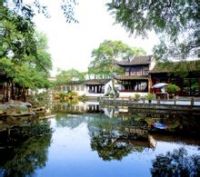Difference between revisions of "Liuyuan Garden"
imported>Superleila m (Created page with 'One of the top four Suzhou gardens, '''Liuyuan (Lingering) Garden''' is a key cultural relic site under national-level protection and occupies 1.88 hectares on Liuyuan Road outsi...') |
imported>Ciic |
||
| Line 1: | Line 1: | ||
| + | [[file: Liu Yuan.JPEG|thumb|200px|left|the Lingering Garden]] | ||
One of the top four Suzhou gardens, '''Liuyuan (Lingering) Garden''' is a key cultural relic site under national-level protection and occupies 1.88 hectares on Liuyuan Road outside [[Suzhou]]’s Changmen Gate. First built in 1593 during the [[Ming Dynasty]] as East Garden, its name was changed into Liuyuan after being purchased and renovated by [[Sheng Kang]], a late [[Qing Dynasty]] high-ranking official. | One of the top four Suzhou gardens, '''Liuyuan (Lingering) Garden''' is a key cultural relic site under national-level protection and occupies 1.88 hectares on Liuyuan Road outside [[Suzhou]]’s Changmen Gate. First built in 1593 during the [[Ming Dynasty]] as East Garden, its name was changed into Liuyuan after being purchased and renovated by [[Sheng Kang]], a late [[Qing Dynasty]] high-ranking official. | ||
The garden is famed for its masterly and naturalistic artistry in dealing with the spaces between various kinds of architectural forms. It includes a central scenic area whose main elements are a lake and rockeries, a constructed area of buildings and courtyards, a landscape scenic area, and a pastoral scenic area. With an expanse of water at the center, it has hills and woods in the northwestern part, and buildings and structures in the southeastern part. The pavilions, terraces and towers in the central section merge with their elegant reflections on the water surface, creating a sublime picture. The houses and courtyards connected by winding corridors in the eastern part of the garden represent the greatest spatial diversity in Suzhou garden architecture. As the largest hall of all Suzhou gardens, its Five Peak Fairy Hall is built with nanmu wood and fitted with elegant mahogany furniture. | The garden is famed for its masterly and naturalistic artistry in dealing with the spaces between various kinds of architectural forms. It includes a central scenic area whose main elements are a lake and rockeries, a constructed area of buildings and courtyards, a landscape scenic area, and a pastoral scenic area. With an expanse of water at the center, it has hills and woods in the northwestern part, and buildings and structures in the southeastern part. The pavilions, terraces and towers in the central section merge with their elegant reflections on the water surface, creating a sublime picture. The houses and courtyards connected by winding corridors in the eastern part of the garden represent the greatest spatial diversity in Suzhou garden architecture. As the largest hall of all Suzhou gardens, its Five Peak Fairy Hall is built with nanmu wood and fitted with elegant mahogany furniture. | ||
[[category:tourism]] | [[category:tourism]] | ||
Latest revision as of 05:15, 15 May 2013
One of the top four Suzhou gardens, Liuyuan (Lingering) Garden is a key cultural relic site under national-level protection and occupies 1.88 hectares on Liuyuan Road outside Suzhou’s Changmen Gate. First built in 1593 during the Ming Dynasty as East Garden, its name was changed into Liuyuan after being purchased and renovated by Sheng Kang, a late Qing Dynasty high-ranking official.
The garden is famed for its masterly and naturalistic artistry in dealing with the spaces between various kinds of architectural forms. It includes a central scenic area whose main elements are a lake and rockeries, a constructed area of buildings and courtyards, a landscape scenic area, and a pastoral scenic area. With an expanse of water at the center, it has hills and woods in the northwestern part, and buildings and structures in the southeastern part. The pavilions, terraces and towers in the central section merge with their elegant reflections on the water surface, creating a sublime picture. The houses and courtyards connected by winding corridors in the eastern part of the garden represent the greatest spatial diversity in Suzhou garden architecture. As the largest hall of all Suzhou gardens, its Five Peak Fairy Hall is built with nanmu wood and fitted with elegant mahogany furniture.
